How Well Do You Know Manhattan Landmarks?
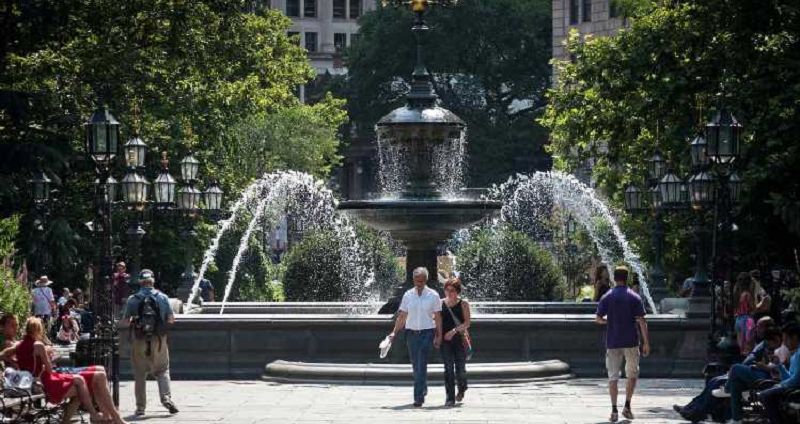
How well do you know Manhattan's designated buildings and sites? Find out with this quiz!
Image via Ed Reed/Mayoral Photography Office
How well do you know Manhattan's designated buildings and sites? Find out with this quiz!
Image via Ed Reed/Mayoral Photography Office
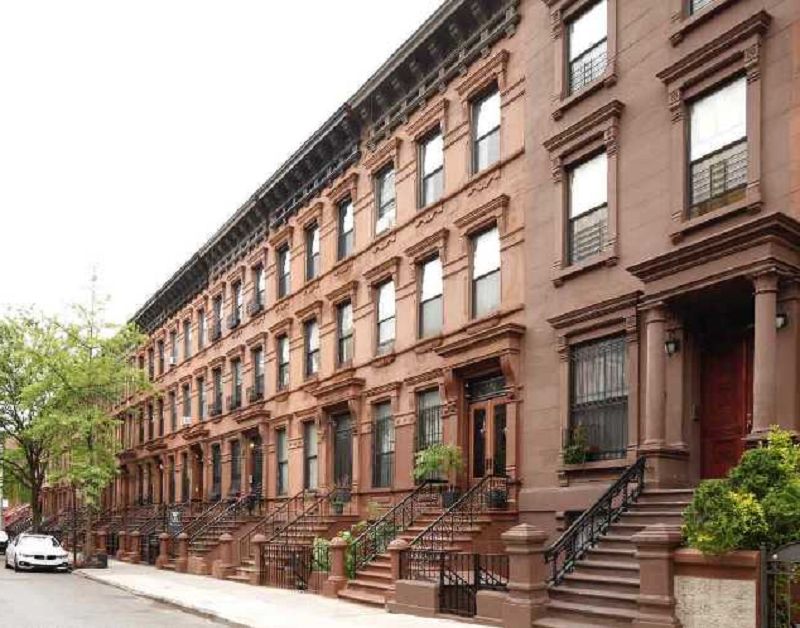
This northern Manhattan historic district was the location of the planning headquarters for the March on Washington for Jobs and Freedom in 1963, an event which was instrumental in spurring the passage of the Civil Rights Act of 1964 and the Voting Rights Act of 1965. What is the name of the historic district?
Image of Bayard Rustin in front of March on Washington HQ via Associated Press
SoHo – Cast Iron Historic District
Central Harlem – West 130th-132nd Street Historic District
Manhattan Avenue Historic District
Madison Square North Historic District
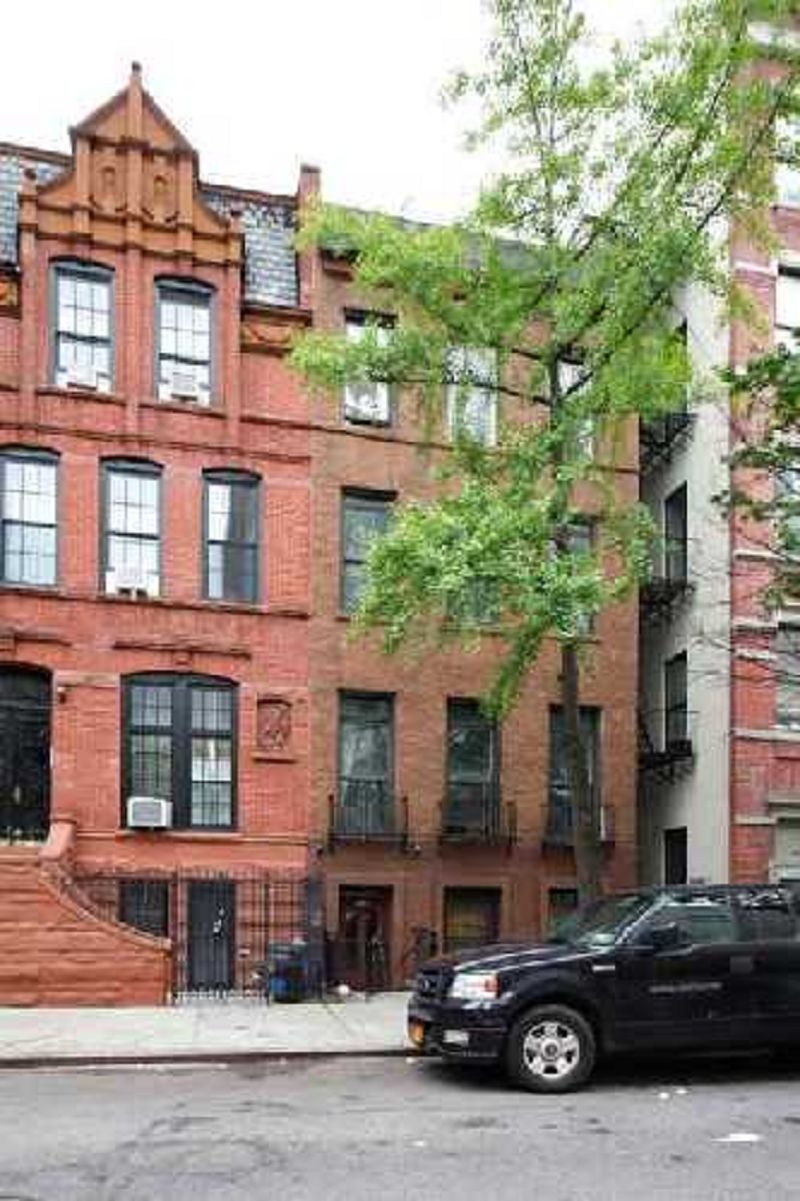
The Central Harlem – West 130th-132nd Street Historic District consists of approximately 164 properties, primarily row houses with a handful of apartment and institutional buildings. A concentration of academics, reverends, doctors, activists, and musicians here created the conditions that made this area home to an impressive variety of cultural, religious, civic, and political activity.
The National Headquarters for the March on Washington for Jobs and Freedom in 1963 was located at 170 West 130th Street in the historic district. The organizers demanded comprehensive and effective civil rights legislation. Civil Rights activist Bayard Rustin was the chief organizer of the march, and from the headquarters, he was involved in planning the route, participating in news conferences, and overseeing transportation and fundraising. Over 100 volunteers and paid employees at the headquarters worked towards mobilizing 100,000 people. Their efforts culminated in what at the time was the nation’s largest political demonstration that helped spur the passage of the Civil Rights Act of 1964 and the Voting Rights Act of 1965.
The historic district was designated in 2018. Explore the Central Harlem – West 130th-132nd Streets Historic District here!
Image of 170 West 130th Street via LPC
The Central Harlem – West 130th-132nd Street Historic District consists of approximately 164 properties, primarily row houses with a handful of apartment and institutional buildings. A concentration of academics, reverends, doctors, activists, and musicians here created the conditions that made this area home to an impressive variety of cultural, religious, civic, and political activity.
The National Headquarters for the March on Washington for Jobs and Freedom in 1963 was located at 170 West 130th Street in the historic district. The organizers demanded comprehensive and effective civil rights legislation. Civil Rights activist Bayard Rustin was the chief organizer of the march, and from the headquarters, he was involved in planning the route, participating in news conferences, and overseeing transportation and fundraising. Over 100 volunteers and paid employees at the headquarters worked towards mobilizing 100,000 people. Their efforts culminated in what at the time was the nation’s largest political demonstration that helped spur the passage of the Civil Rights Act of 1964 and the Voting Rights Act of 1965.
The historic district was designated in 2018. Explore the Central Harlem – West 130th-132nd Streets Historic District here!
Image of 170 West 130th Street via LPC
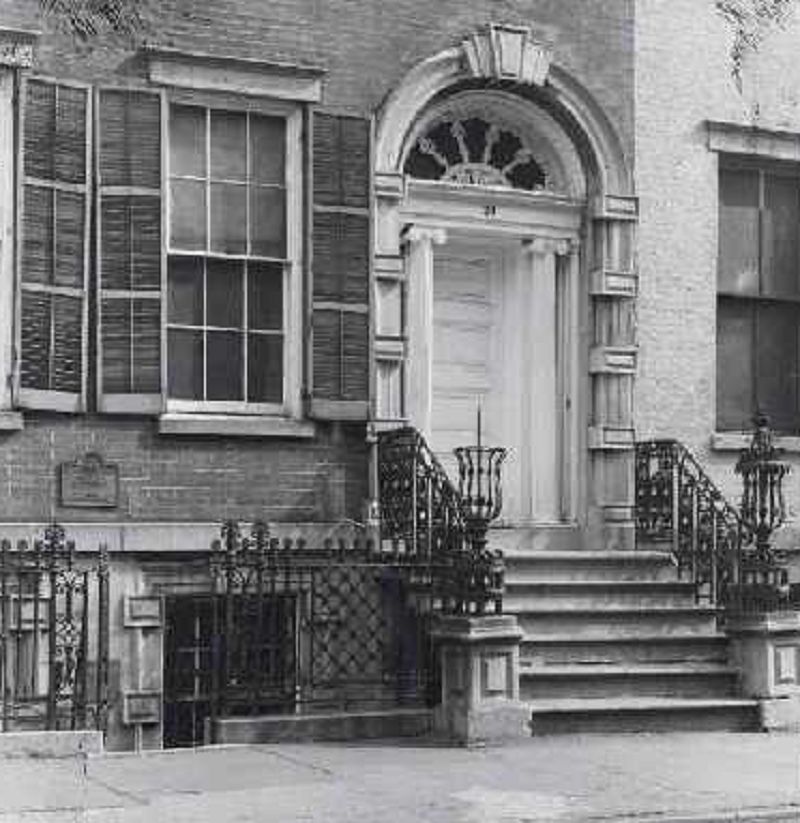
Which statements are true about the Old Merchant’s House (Seabury Treadwell House) at 29 East 4th Street?
Image via LPC
It was the first landmark in Manhattan
It is an exceptionally fine example of late Federal/Greek Revival architecture
It documents how a prosperous NYC merchant and his family lived in the mid-19th century
All of the above
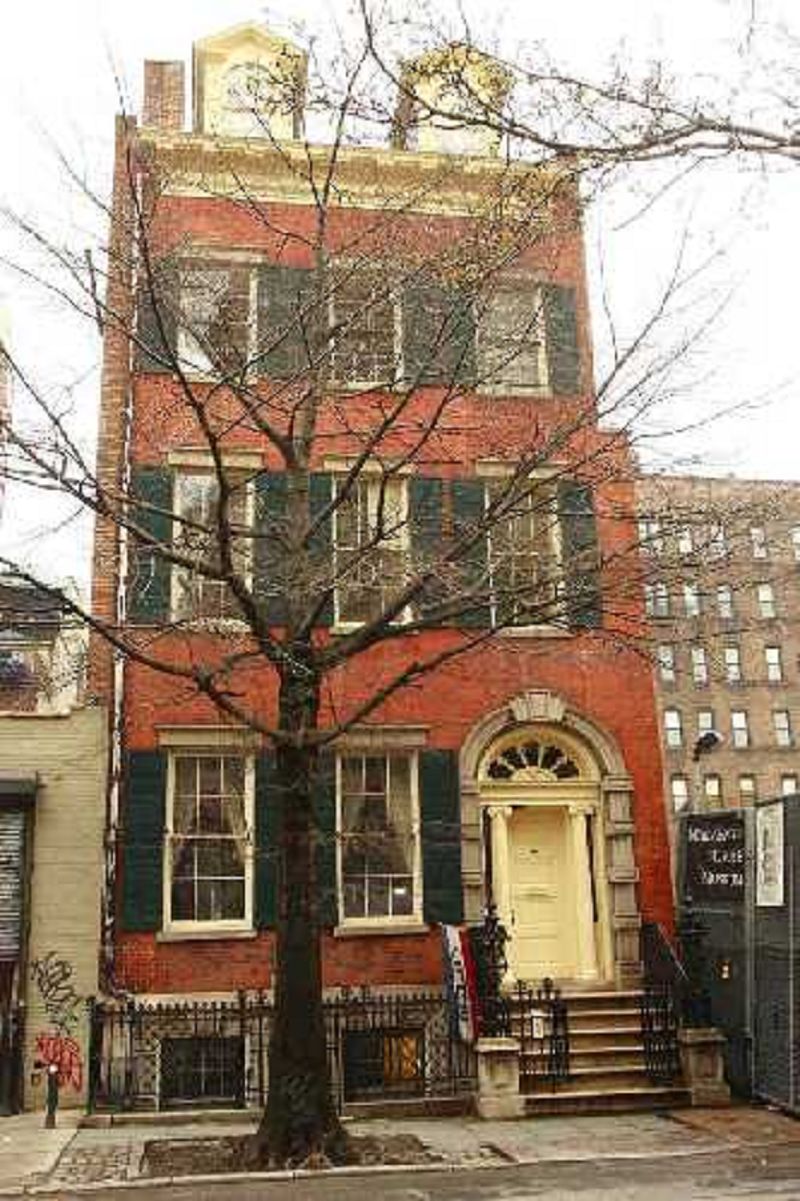
All of the answers are true.
Built in 1832, this 3-story brick row house was once home to merchant Seabury Treadwell. While its design has been attributed to notable architect Minard Lefever, whose 19th century pattern books helped popularize the Greek Revival style in architecture, it seems most likely that the design of the Old Merchant’s House resulted from the skills of a New York builder and the easy availability of mass-produced architectural items. Originally part of a row of six identical buildings, Treadwell’s daughter was born in the house in 1840 and died there in 1933, after which time the house was purchased and preserved intact as a museum. The building is a unique document of its period and shows with unrivaled authenticity how the family of a prosperous merchant of the 1830s lived. Designated on October 14, 1965, it was LPC’s first designation in Manhattan. In 1981, the building’s interior was also designated a landmark.
The Old Merchant’s House is located directly adjacent to the NoHo Historic District and NoHo Historic District Extension, which represent the period of New York City’s commercial history from the mid-19th to early 20th centuries, when this section prospered as one of its major retail and wholesale dry goods centers.
Image via Commons:Wikipedia Takes Manhattan
All of the answers are true.
Built in 1832, this 3-story brick row house was once home to merchant Seabury Treadwell. While its design has been attributed to notable architect Minard Lefever, whose 19th century pattern books helped popularize the Greek Revival style in architecture, it seems most likely that the design of the Old Merchant’s House resulted from the skills of a New York builder and the easy availability of mass-produced architectural items. Originally part of a row of six identical buildings, Treadwell’s daughter was born in the house in 1840 and died there in 1933, after which time the house was purchased and preserved intact as a museum. The building is a unique document of its period and shows with unrivaled authenticity how the family of a prosperous merchant of the 1830s lived. Designated on October 14, 1965, it was LPC’s first designation in Manhattan. In 1981, the building’s interior was also designated a landmark.
The Old Merchant’s House is located directly adjacent to the NoHo Historic District and NoHo Historic District Extension, which represent the period of New York City’s commercial history from the mid-19th to early 20th centuries, when this section prospered as one of its major retail and wholesale dry goods centers.
Image via Commons:Wikipedia Takes Manhattan
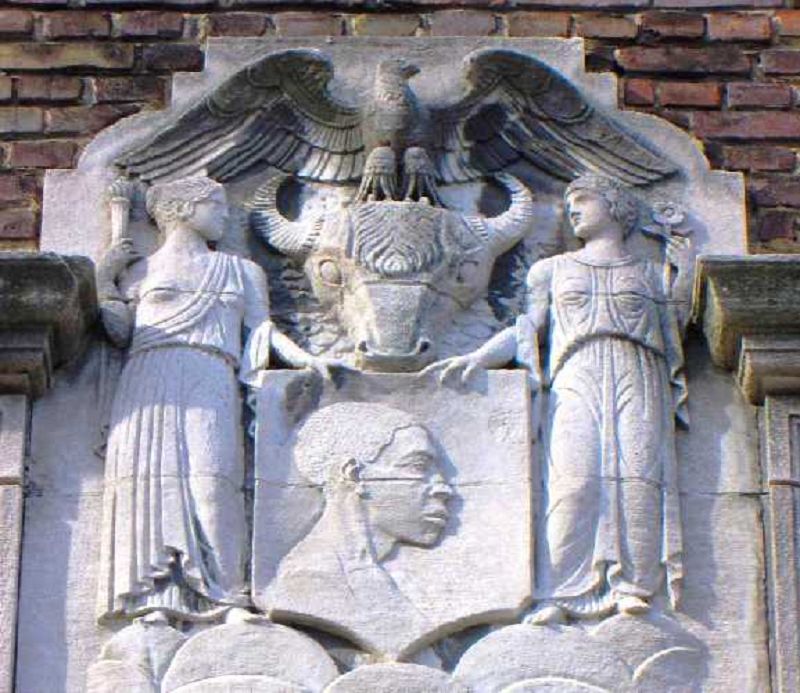
This landmark in Harlem, named after a noted African-American poet, was the first large cooperative built for African Americans and was Manhattan’s earliest large garden apartment complex. What is the name of the landmark?
Building detail via Wikimedia Commons user Beyond My Ken
Dunbar Apartments
Roosevelt Building
San Remo Apartments
Astor Row
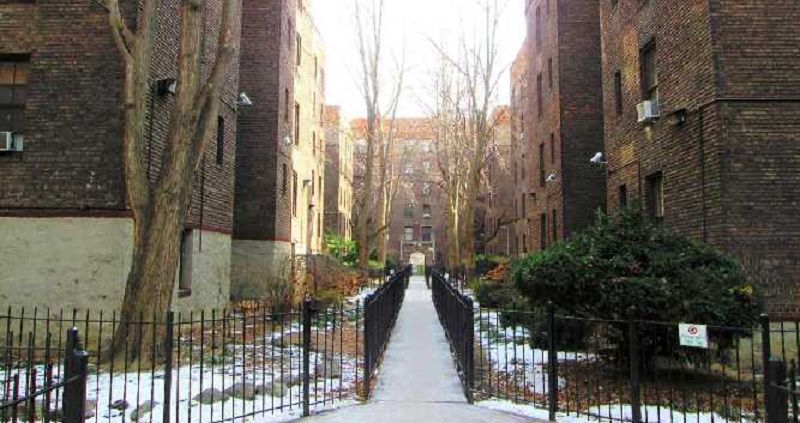
The Dunbar Apartments, named after the famous poet Paul Lawrence Dunbar (1872-1906), occupies the entire block bounded by 149th and 150th streets and Seventh and Eighth avenues. Financed by John D. Rockefeller, Jr., and designed by the architect Andrew J. Thomas, the complex was completed in 1928 and was destined, from the planning and sociological points of view, to occupy a pivotal place in the history of the Harlem community. The complex consists of six independent U-shaped buildings, containing 511 apartments clustered around a large interior garden court. With its lawns, shrubs and trees, the garden court provides a quiet, green oasis removed from the traffic and noise of the surrounding streets.
Thomas avoided the cold monotony of many later housing projects by varying the heights of the buildings from five to six stories and introducing a variety of window alignments and sizes. The warm tones of the brick are set off by decorative accents of limestone. Wrought iron balconies and window guards and architectural terra cotta at the roof level complete the decorative scheme. The Dunbar Apartments were designated a New York City landmark in 1970.
Image via Wikimedia Commons user Beyond My Ken
The Dunbar Apartments, named after the famous poet Paul Lawrence Dunbar (1872-1906), occupies the entire block bounded by 149th and 150th streets and Seventh and Eighth avenues. Financed by John D. Rockefeller, Jr., and designed by the architect Andrew J. Thomas, the complex was completed in 1928 and was destined, from the planning and sociological points of view, to occupy a pivotal place in the history of the Harlem community. The complex consists of six independent U-shaped buildings, containing 511 apartments clustered around a large interior garden court. With its lawns, shrubs and trees, the garden court provides a quiet, green oasis removed from the traffic and noise of the surrounding streets.
Thomas avoided the cold monotony of many later housing projects by varying the heights of the buildings from five to six stories and introducing a variety of window alignments and sizes. The warm tones of the brick are set off by decorative accents of limestone. Wrought iron balconies and window guards and architectural terra cotta at the roof level complete the decorative scheme. The Dunbar Apartments were designated a New York City landmark in 1970.
Image via Wikimedia Commons user Beyond My Ken
Architect William Lescaze’s eponymous house and office at 211 East 48th Street was constructed between 1933 and 1934 and is considered the first truly modern residence in New York City. In its construction, Lescaze pioneered the use of what material?
Wood shake shingles
Terra cota tiles
Glass blocks and bricks
Cast stone
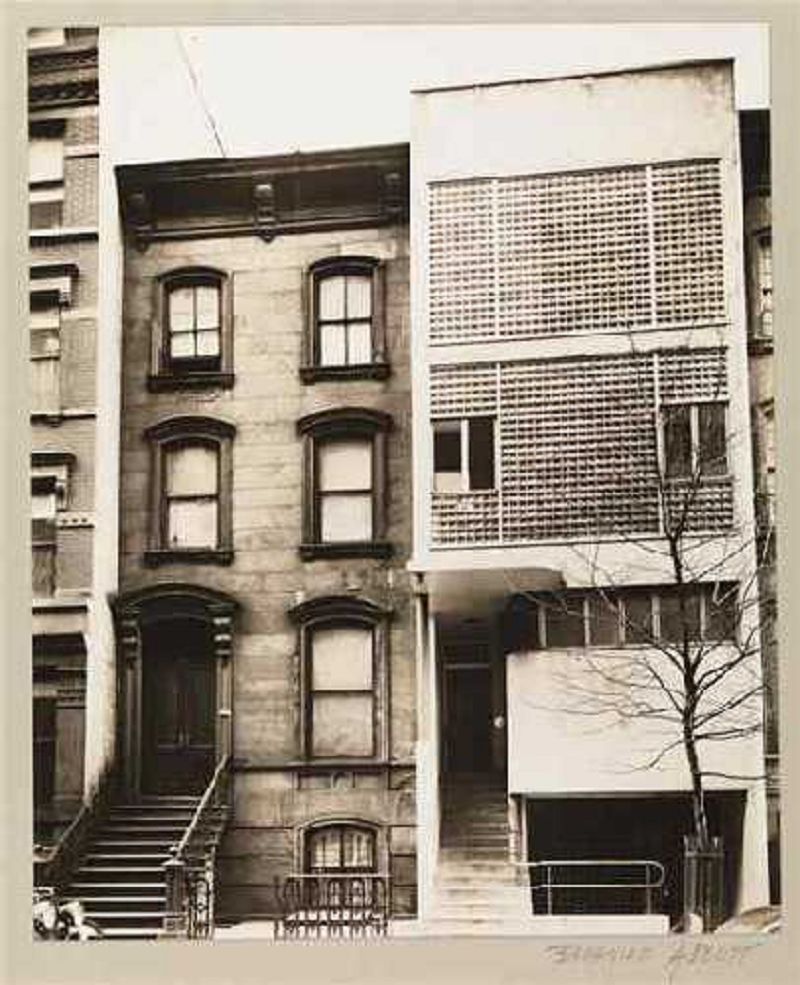
This New York City landmark is an embodiment of the theory and practice of William Lescaze, one of the most influential and articulate exponents of the modern movement in architecture whose goal was the creation of structures which were expressive of the life of the 20th century.
The structural use of glass blocks and glass bricks appeared in this house for the first time in New York City. The hollow glass blocks provide privacy, insulation from cold and heat, and protection from dirt and noise. In addition, they are a permanent building material, requiring little or no maintenance. The Macbeth-Evans Company, founded in 1899 in Pittsburgh, is credited with their manufacture in a two-page advertisement featuring the Lescaze House in the Architectural Forum of December 1934. The large glazed areas of the facade are not only interesting technically and as a fun
Image by Berenice Abbott via MCNY
This New York City landmark is an embodiment of the theory and practice of William Lescaze, one of the most influential and articulate exponents of the modern movement in architecture whose goal was the creation of structures which were expressive of the life of the 20th century.
The structural use of glass blocks and glass bricks appeared in this house for the first time in New York City. The hollow glass blocks provide privacy, insulation from cold and heat, and protection from dirt and noise. In addition, they are a permanent building material, requiring little or no maintenance. The Macbeth-Evans Company, founded in 1899 in Pittsburgh, is credited with their manufacture in a two-page advertisement featuring the Lescaze House in the Architectural Forum of December 1934. The large glazed areas of the facade are not only interesting technically and as a fun
Image by Berenice Abbott via MCNY
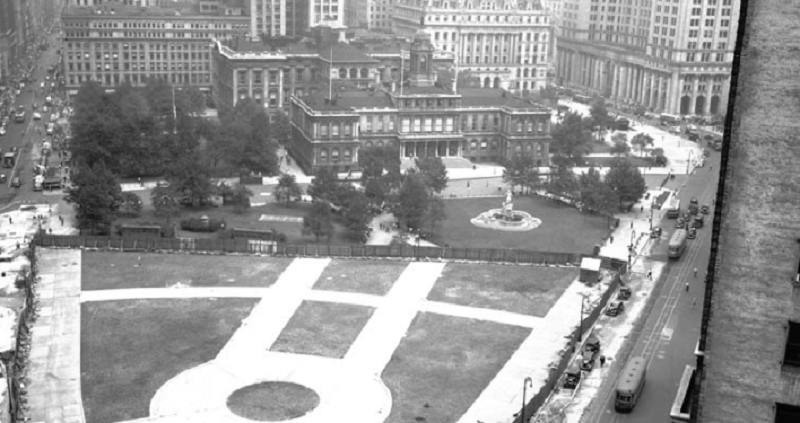
Street Plan of New Amsterdam and Colonial New York
African Burial Ground and the Commons Historic District
South Street Seaport Historic District
Ellis Island Historic District
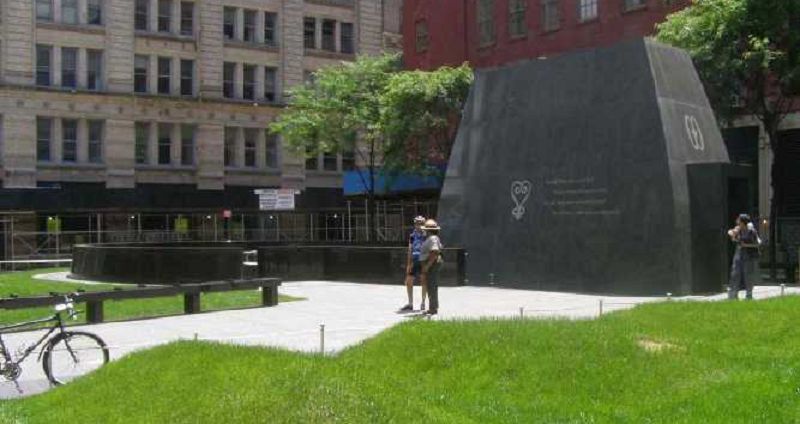
The African Burial Ground and the Commons Historic District, designated in 1993, was the LPC's first archaeological historic district and is the oldest known African-American cemetery in New York City. The New Amsterdam Commons, an area formed by the Dutch colonial government, experienced intense public use starting in the mid-17th century, resulting in the overlay of many significant historic improvements and resources – both above ground and below – all of which document the changing nature of this important area long devoted to communal, public, and civic purposes.
Throughout much of the 18th century, and maybe earlier, New York’s free and enslaved Africans buried their dead in a portion of the New Amsterdam Commons, which is now north of City Hall Park. Archaeological excavations revealed the presence of the burial ground under much of the site, due to deep levels of fill which have protected the original ground surface and an intact stratum of burials. The approximately 400 burials fully excavated by archaeologists have provided rare, important material evidence of 18th century African life and culture in New York. The African Burial Ground serves as a memorial to a people who came to America in bondage rather than by choice, and who lived, died, and were buried within a community which has been largely unacknowledged in historical studies of the colonial world.
Image via Wikimedia Commons user Chris Light
The African Burial Ground and the Commons Historic District, designated in 1993, was the LPC's first archaeological historic district and is the oldest known African-American cemetery in New York City. The New Amsterdam Commons, an area formed by the Dutch colonial government, experienced intense public use starting in the mid-17th century, resulting in the overlay of many significant historic improvements and resources – both above ground and below – all of which document the changing nature of this important area long devoted to communal, public, and civic purposes.
Throughout much of the 18th century, and maybe earlier, New York’s free and enslaved Africans buried their dead in a portion of the New Amsterdam Commons, which is now north of City Hall Park. Archaeological excavations revealed the presence of the burial ground under much of the site, due to deep levels of fill which have protected the original ground surface and an intact stratum of burials. The approximately 400 burials fully excavated by archaeologists have provided rare, important material evidence of 18th century African life and culture in New York. The African Burial Ground serves as a memorial to a people who came to America in bondage rather than by choice, and who lived, died, and were buried within a community which has been largely unacknowledged in historical studies of the colonial world.
Image via Wikimedia Commons user Chris Light
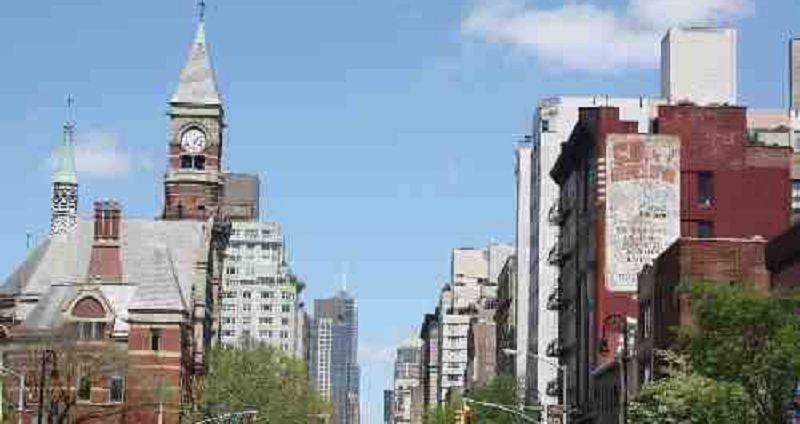
Which building located in the Greenwich Village Historic District (or its extension) was designated an individual landmark for its significance to LGBT history?
Image via Wikimedia Commons user Sam McIntosh
Stonewall Inn
The Lesbian, Gay, Bisexual, Transgender Community Center
The Caffe Cino
All of the above
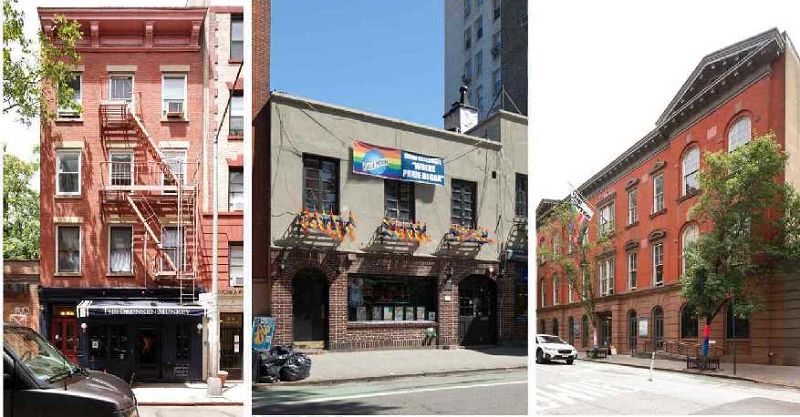
All of the answers are correct.
For more than 150 years, Greenwich Village has been associated with creativity and political activism, known within New York City and the country as the mecca for bohemian life and a place that embraced unconventional lifestyles. The neighborhood’s tolerance made the Village a haven for LGBTQ people as far back as the early-20th century.
The Caffe Cino (left), which occupied the ground floor commercial space at 31 Cornelia Street from 1958 to 1968, was the birthplace of Off-Off-Broadway and New York City’s first gay theater. The recognition and encouragement of the homosexual experience that was exhibited at the Caffe Cino, both on and off stage, helped build the foundation for the LGBT liberation movement that was subsequently launched by the Stonewall Rebellion in 1969. The Stonewall Inn (center), a Greenwich Village gay bar originally constructed in 1843, was the starting point of the Stonewall Rebellion and a major catalyst in the fight for LGBT rights in the United States. Also in Greenwich Village, the Lesbian, Gay, Bisexual & Transgender Community Center (right) was established in 1984 and continues today to serve the LGBT Community through political action, social, and health and wellness programs. The Stonewall Inn was designated an individual landmark in 2015; both the LGBT Community Center and the Caffe Cino were designated as individual landmarks in 2019.
All images via LPC
All of the answers are correct.
For more than 150 years, Greenwich Village has been associated with creativity and political activism, known within New York City and the country as the mecca for bohemian life and a place that embraced unconventional lifestyles. The neighborhood’s tolerance made the Village a haven for LGBTQ people as far back as the early-20th century.
The Caffe Cino (left), which occupied the ground floor commercial space at 31 Cornelia Street from 1958 to 1968, was the birthplace of Off-Off-Broadway and New York City’s first gay theater. The recognition and encouragement of the homosexual experience that was exhibited at the Caffe Cino, both on and off stage, helped build the foundation for the LGBT liberation movement that was subsequently launched by the Stonewall Rebellion in 1969. The Stonewall Inn (center), a Greenwich Village gay bar originally constructed in 1843, was the starting point of the Stonewall Rebellion and a major catalyst in the fight for LGBT rights in the United States. Also in Greenwich Village, the Lesbian, Gay, Bisexual & Transgender Community Center (right) was established in 1984 and continues today to serve the LGBT Community through political action, social, and health and wellness programs. The Stonewall Inn was designated an individual landmark in 2015; both the LGBT Community Center and the Caffe Cino were designated as individual landmarks in 2019.
All images via LPC
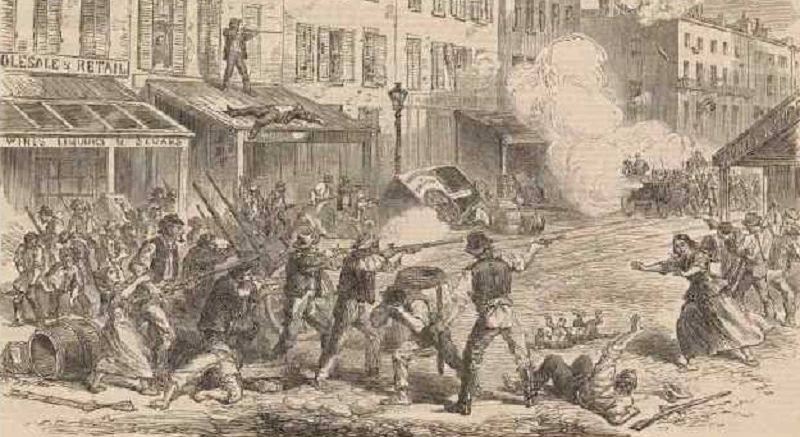
The home of Abby and James Gibbons in the Lamartine Place Historic District was attacked and burned during the 1863 Draft Riots as a result of their association with what 19th century movement?
Image via NYPL Digital Collections
Mystic
Temperance
Abolitionist
Transcendentalist
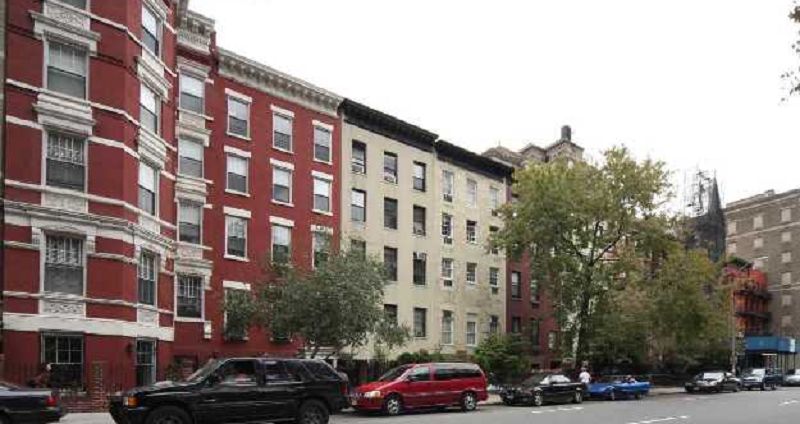
The Lamartine Place Historic District is an intact row of houses constructed in the late-1840s and early 1850s. It includes the home of prominent abolitionists Abby Hopper Gibbons and James Sloan Gibbons, whose house at 339 West 29th Street was used as a meeting place for influential people in the movement and as a documented stop on the Underground Railroad. Because of their abolitionist activity, the house was attacked and burned during the 1863 Draft Riots, during which several family members escaped the fire and the mob by climbing over neighboring roofs to a waiting carriage on Ninth Avenue. While this building was the prime target of the rioters on this block, other houses in the row played an important role in these events. Abby Gibbons’ sister and her family lived at 335 Lamartine Place, and members of the Hopper family took refuge there during the attack. The Lamartine Place Historic District was designated in 2009.
Image via LPC
The Lamartine Place Historic District is an intact row of houses constructed in the late-1840s and early 1850s. It includes the home of prominent abolitionists Abby Hopper Gibbons and James Sloan Gibbons, whose house at 339 West 29th Street was used as a meeting place for influential people in the movement and as a documented stop on the Underground Railroad. Because of their abolitionist activity, the house was attacked and burned during the 1863 Draft Riots, during which several family members escaped the fire and the mob by climbing over neighboring roofs to a waiting carriage on Ninth Avenue. While this building was the prime target of the rioters on this block, other houses in the row played an important role in these events. Abby Gibbons’ sister and her family lived at 335 Lamartine Place, and members of the Hopper family took refuge there during the attack. The Lamartine Place Historic District was designated in 2009.
Image via LPC
These landmarks have all been the settings of childrens’ books. Which landmark was actually a main character?
Jeffrey's Hook Lighthouse
Plaza Hotel
Central Park
New York Public Library
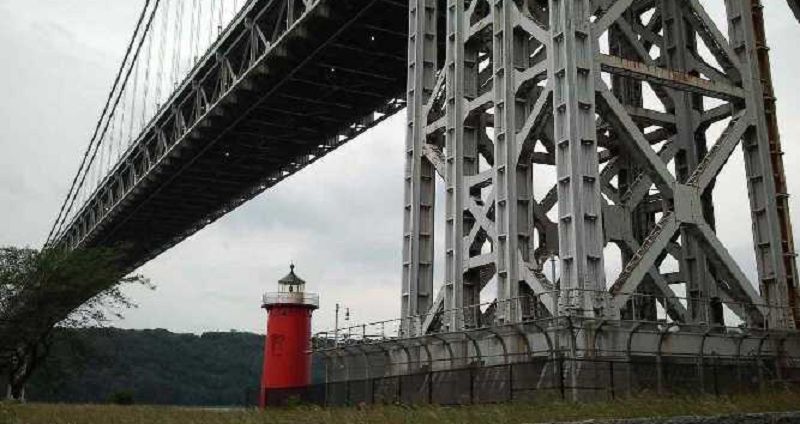
Jeffrey’s Hook Lighthouse, a.k.a. the Little Red Lighthouse, was originally erected in Sandy Hook, NJ in 1880. Moved to Jeffrey’s Hook on the Hudson River in 1921, it served as a navigation aid until 1951. Best known as the main character in Hildegarde Swift’s beloved 1942 book The Little Red Lighthouse and the Great Gray Bridge, the lighthouse was saved from demolition by an outcry from the city’s children and is now a feature in Fort Washington Park.
Image via Wikimedia Commons user Gigi alt
Jeffrey’s Hook Lighthouse, a.k.a. the Little Red Lighthouse, was originally erected in Sandy Hook, NJ in 1880. Moved to Jeffrey’s Hook on the Hudson River in 1921, it served as a navigation aid until 1951. Best known as the main character in Hildegarde Swift’s beloved 1942 book The Little Red Lighthouse and the Great Gray Bridge, the lighthouse was saved from demolition by an outcry from the city’s children and is now a feature in Fort Washington Park.
Image via Wikimedia Commons user Gigi alt
In the 20th century, four Manhattan landmarks held the title of tallest building in the world. Which one held the honor for the shortest period of time?
Metropolitan Life Insurance Company Tower
Woolworth Building
Chrysler Building
Empire State Building

The Metropolitan Life Insurance Co. Tower on Madison Square (1906-09, Pierre Le Brun), at 700 feet, held the title of world's tallest building from 1909 to 1913, until the 800-foot-tall Woolworth Building (1910-13, Cass Gilbert) was completed. The Woolworth Building held the title until 1929. The Chrysler Building (1928-30, William Van Alen) was the tallest building in the world for only two years, from 1929 to 1931, until the title went to the Empire State Building. The Empire State Building (1929-31, Shreve, Lamb & Harmon) which topped out at 102 stories (including the mast), held the title the longest – from 1931 to 1973, until the Twin Towers of the World Trade Center were completed.
Fun Fact: William Van Alen, the architect of the Chrysler Building, was competing for the tallest title against H. Craig Severance, who was then completing the Bank of Manhattan at 40 Wall Street. In an attempt to win the title, Severance added a tall flag pole to the top of the bank; meanwhile, Van Alen was secretly assembling the Chrysler’s 185-foot tall spire inside the building and in November 1929 had it hoisted into place, besting the competition by more than 100 feet.
Image of Chrysler Building via Wikimedia Commons user Daniel Dimitrov
The Metropolitan Life Insurance Co. Tower on Madison Square (1906-09, Pierre Le Brun), at 700 feet, held the title of world's tallest building from 1909 to 1913, until the 800-foot-tall Woolworth Building (1910-13, Cass Gilbert) was completed. The Woolworth Building held the title until 1929. The Chrysler Building (1928-30, William Van Alen) was the tallest building in the world for only two years, from 1929 to 1931, until the title went to the Empire State Building. The Empire State Building (1929-31, Shreve, Lamb & Harmon) which topped out at 102 stories (including the mast), held the title the longest – from 1931 to 1973, until the Twin Towers of the World Trade Center were completed.
Fun Fact: William Van Alen, the architect of the Chrysler Building, was competing for the tallest title against H. Craig Severance, who was then completing the Bank of Manhattan at 40 Wall Street. In an attempt to win the title, Severance added a tall flag pole to the top of the bank; meanwhile, Van Alen was secretly assembling the Chrysler’s 185-foot tall spire inside the building and in November 1929 had it hoisted into place, besting the competition by more than 100 feet.
Image of Chrysler Building via Wikimedia Commons user Daniel Dimitrov
Many landmarks in Manhattan are associated with famous historic figures in American history. While most are original constructions, such as Alexander Hamilton’s house, The Grange; Cooper Union, where Abraham Lincoln spoke; and the Ulysses S. Grant Tomb, others are early 20th century recreations. Which of the following are recreations of older buildings?
Fraunces Tavern
Theodore Roosevelt Birthplace
Castle Clinton
Both Fraunces Tavern and Theodore Roosevelt Birthplace

Both Fraunces Tavern and the Theodore Roosevelt Birthplace are recreations.
Fraunces Tavern (left) at 54 Pearl Street (1904, William H. Mersereau) is a recreation of the tavern established by Samuel Fraunces in 1763 where Gen. George Washington bid farewell to his officers in an address on December 4, 1783.
The Theodore Roosevelt Birthplace (right) at 28 East 20th Street (1923, Theodate Pope Riddle) replaced the original Roosevelt house, which had been demolished in 1916. Riddle, one of America’s first female architects, designed the home to replicate the house’s 1865 appearance, when a mansard roof was added to what had been a Gothic Revival style house. Roosevelt’s uncle’s house next door, then extant but heavily altered, was razed to make room for a modest museum dedicated to our 26th President.
Image of Fraunces Tavern via Wikimedia Commons user Jim.henderson
Image of Theodore Roosevelt Birthplace via National Parks Service
Both Fraunces Tavern and the Theodore Roosevelt Birthplace are recreations.
Fraunces Tavern (left) at 54 Pearl Street (1904, William H. Mersereau) is a recreation of the tavern established by Samuel Fraunces in 1763 where Gen. George Washington bid farewell to his officers in an address on December 4, 1783.
The Theodore Roosevelt Birthplace (right) at 28 East 20th Street (1923, Theodate Pope Riddle) replaced the original Roosevelt house, which had been demolished in 1916. Riddle, one of America’s first female architects, designed the home to replicate the house’s 1865 appearance, when a mansard roof was added to what had been a Gothic Revival style house. Roosevelt’s uncle’s house next door, then extant but heavily altered, was razed to make room for a modest museum dedicated to our 26th President.
Image of Fraunces Tavern via Wikimedia Commons user Jim.henderson
Image of Theodore Roosevelt Birthplace via National Parks Service
Harlem’s cultural and architectural significance is represented in historic districts as well as individual landmarks, including many stunning churches with rich African-American history. Which of these Harlem churches is a New York City landmark?
Mother African Methodist Episcopal Zion Church
Abyssinian Baptist Church
St. Philip's Episcopal Church
All of the above
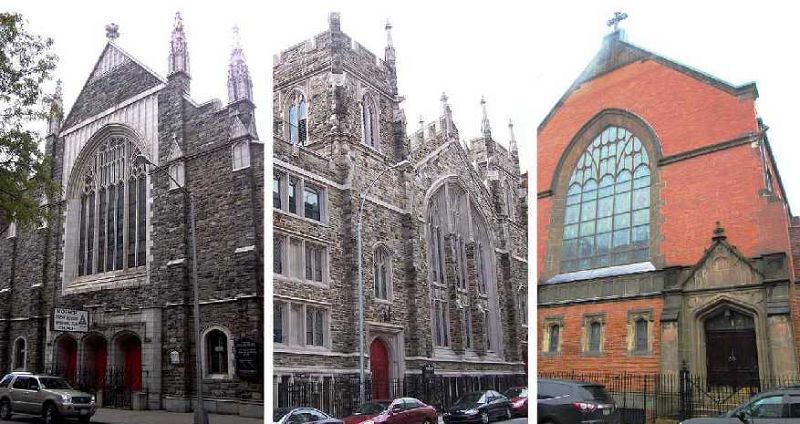
All of these churchs are New York City landmarks.
Mother African Methodist Episcopal (A.M.E.) Zion Church (left) is the oldest African-American church congregation in New York and the “mother” church of the A.M.E. Zion denomination. The church was designed by George W. Foster, Jr., one of the first black architects in America and one of the first two African-American architects registered in the State of New Jersey.
Abyssinian Baptist Church and Community House (center) (1922-23, Charles W. Bolton & Son) is the second-oldest African-American church in New York City and is famous for its prominent ministers, Reverend Dr. Adam Clayton Powell, Sr., his son Congressman Adam Clayton Powell, Jr., Reverend Dr. Samuel DeWitt Proctor, and the current pastor Reverend Dr. Calvin O. Butts, III.
St. Philip’s Episcopal Church (right) is the home of New York City’s oldest African-American Episcopal congregation, established in Lower Manhattan in 1818. The neo-Gothic style church was designed in 1910-11 by Vertner Tandy and George W. Foster, Jr. Two of America’s first African-American architects.
Image of Mother AME Zion and Abyssinian Baptist via Wikimedia Commons user DennisinAmsterdam
Image of St. Philip's via Wikimedia Commos user Beyond My Ken
All of these churchs are New York City landmarks.
Mother African Methodist Episcopal (A.M.E.) Zion Church (left) is the oldest African-American church congregation in New York and the “mother” church of the A.M.E. Zion denomination. The church was designed by George W. Foster, Jr., one of the first black architects in America and one of the first two African-American architects registered in the State of New Jersey.
Abyssinian Baptist Church and Community House (center) (1922-23, Charles W. Bolton & Son) is the second-oldest African-American church in New York City and is famous for its prominent ministers, Reverend Dr. Adam Clayton Powell, Sr., his son Congressman Adam Clayton Powell, Jr., Reverend Dr. Samuel DeWitt Proctor, and the current pastor Reverend Dr. Calvin O. Butts, III.
St. Philip’s Episcopal Church (right) is the home of New York City’s oldest African-American Episcopal congregation, established in Lower Manhattan in 1818. The neo-Gothic style church was designed in 1910-11 by Vertner Tandy and George W. Foster, Jr. Two of America’s first African-American architects.
Image of Mother AME Zion and Abyssinian Baptist via Wikimedia Commons user DennisinAmsterdam
Image of St. Philip's via Wikimedia Commos user Beyond My Ken
Manhattan’s residential neighborhoods are comprised primarily of apartment buildings and row houses, but some contain small unique enclaves of houses, sometimes off the Manhattan grid, which feel like hidden gems. One such place was designed to emulate the village atmosphere of a popular play by Lewis Parker for which it was named. What is the place?
Sniffin Court
Patchin Place
Pomander Walk
Washington Mews
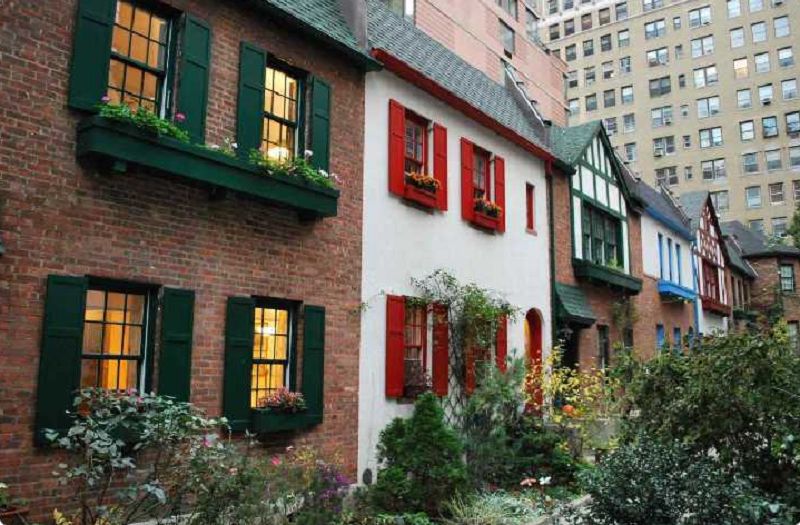
Pomander Walk, a designated individual landmark within the Riverside-West End Historic District Extension II, consists of 16 neo-Tudor row houses facing each other across a through-block walkway and eleven additional buildings on West 94th and 95th Streets. Pomander Walk has a unique sense of place; secluded from the street, it creates a delightful world of picturesque dwellings replete with half timbering, gables, and other vernacular Tudoresque embellishments. The almost magical atmosphere created by this small residential enclave was very much the intention of Thomas Healy, who in 1921, commissioned the architectural firm of King & Campbell to design a residential complex that would recreate the village atmosphere of Lewis Parker's then popular period comedy, Pomander Walk.
Image via Wikimedia Commons user Sonja Stark
Pomander Walk, a designated individual landmark within the Riverside-West End Historic District Extension II, consists of 16 neo-Tudor row houses facing each other across a through-block walkway and eleven additional buildings on West 94th and 95th Streets. Pomander Walk has a unique sense of place; secluded from the street, it creates a delightful world of picturesque dwellings replete with half timbering, gables, and other vernacular Tudoresque embellishments. The almost magical atmosphere created by this small residential enclave was very much the intention of Thomas Healy, who in 1921, commissioned the architectural firm of King & Campbell to design a residential complex that would recreate the village atmosphere of Lewis Parker's then popular period comedy, Pomander Walk.
Image via Wikimedia Commons user Sonja Stark
Which of the following designated New York Public Library branches is the oldest operating branch in the system?
Hint: It is located in the East Village.
Ottendorfer Branch
Jefferson Market Branch
Muhlenberg Branch
Aguilar Branch
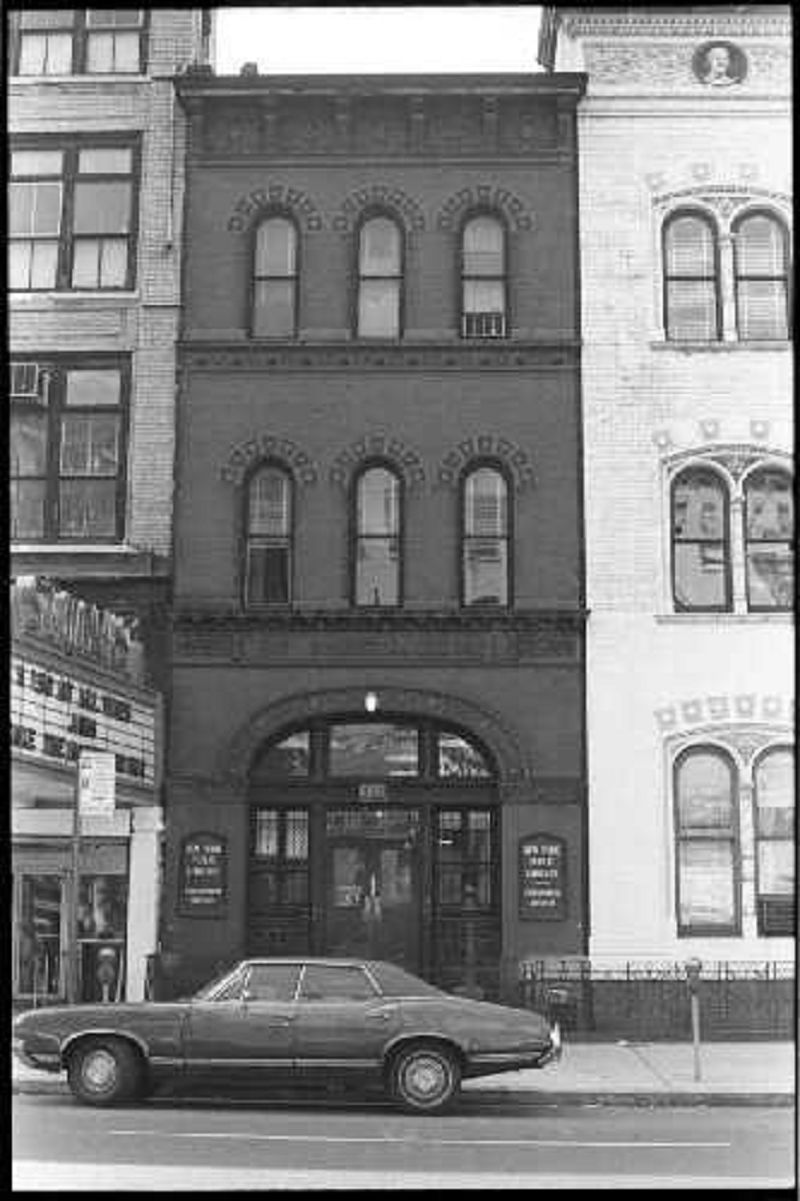
Originally operated by the New York Free Circulating Library, which merged with the New York Public Library in 1901, the Ottendorfer Branch was designed in 1883-84 by William Schickel and built by the philanthropist Oswald Ottendorfer, publisher of the Staats-Zeitung, and his wife Anna. It has been in continuous use since it opened. It is located in the East Village on Second Avenue at St. Mark’s Place.
Image via LPC
Originally operated by the New York Free Circulating Library, which merged with the New York Public Library in 1901, the Ottendorfer Branch was designed in 1883-84 by William Schickel and built by the philanthropist Oswald Ottendorfer, publisher of the Staats-Zeitung, and his wife Anna. It has been in continuous use since it opened. It is located in the East Village on Second Avenue at St. Mark’s Place.
Image via LPC
Prior to 19th century changes in building code, many of Manhattan's buildings were constructed of wood. Among the borough's few remaining wooden houses is this landmark, which is also its only remaining Dutch Colonial style farmhouse. What is the landmark?
Dyckman House
Gracie Mansion
412 East 85th Street House
312-314 East 53rd Street Houses

Dyckman House, at the corner of Broadway and West 204th Street, was built c. 1785 and restored by Alexander M. Welch in 1915-16. Constructed of field stone and brick as well as wood, it features the gambrel roof, spring eaves, and porch typical of the style. Threatened by demolition in 1915, two Dyckman sisters initiated the restoration of the house, which was then presented to the city.
Image via LPC
Dyckman House, at the corner of Broadway and West 204th Street, was built c. 1785 and restored by Alexander M. Welch in 1915-16. Constructed of field stone and brick as well as wood, it features the gambrel roof, spring eaves, and porch typical of the style. Threatened by demolition in 1915, two Dyckman sisters initiated the restoration of the house, which was then presented to the city.
Image via LPC
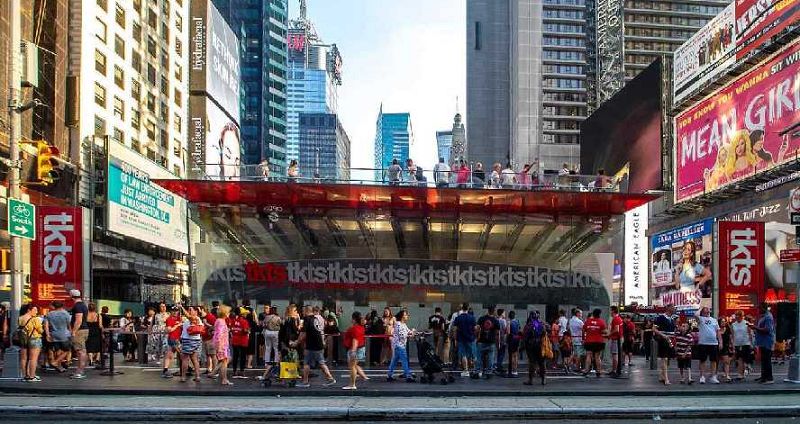
Widely known for its Broadway theaters, now centered around Times Square, New York City’s vibrant theater community has also formed Off-Broadway and Off-Off-Broadway theaters, producing plays in repurposed former commercial, industrial, institutional or religious buildings. Which of these theaters is in a landmark building?
Image via Wikimedia Commons user Ajay Suresh
La Mama Experimental Theater
Joseph Papp Public Theater
Cherry Lane Theater
All of the above
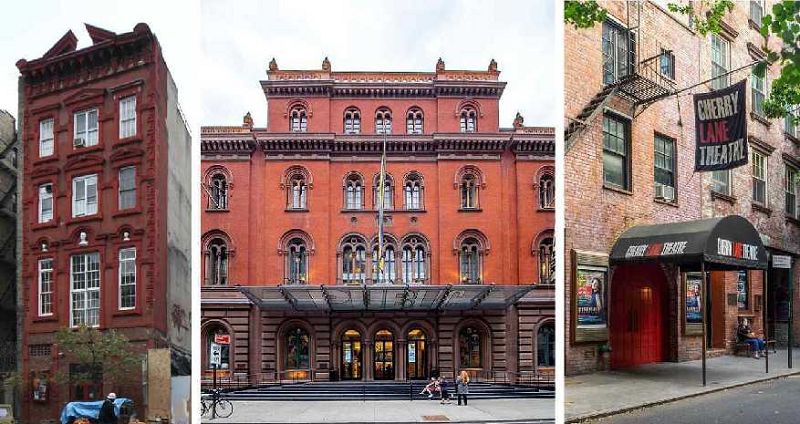
All of these theaters are located in designated buildings.
The La Mama Experimental Theater, founded by Ellen Stewart in 1961, has called the former Aschenbroedel Verein Building at 74 East 4th Street home since 1969. The building, designed by August H. Blenkenstein in 1873, was originally the headquarters of a social and benevolent association for German-American professional orchestral musicians and conductors.
The Astor Library, the city’s first public library, was built in three sections between 1849 and 1881. Converted into a theater for Joseph Papp in 1966 by architect Giorgio Cavaglieri, it has been the home of the Joseph Papp Public Theater since that time.
The Cherry Lane Theater has been located in a former brewery at 38 Commerce Street in the Greenwich Village Historic District since 1924.
Fun Fact: Over the years, the Landmarks Preservation Commission has designated 28 Broadway theaters as individual and/or interior landmarks. Among the other theaters and concert halls designated by the Commission are Carnegie Hall, Town Hall, the Apollo Theater, the Beacon Theater, and Rockefeller Center.
Image of Aschenbroedel Verein Building via LPC
Image of Astor Library via Wikimedia Commons user Ajay Suresh
Image of 38 Commerce Street via Wikimedia Commons user Ajay Suresh
All of these theaters are located in designated buildings.
The La Mama Experimental Theater, founded by Ellen Stewart in 1961, has called the former Aschenbroedel Verein Building at 74 East 4th Street home since 1969. The building, designed by August H. Blenkenstein in 1873, was originally the headquarters of a social and benevolent association for German-American professional orchestral musicians and conductors.
The Astor Library, the city’s first public library, was built in three sections between 1849 and 1881. Converted into a theater for Joseph Papp in 1966 by architect Giorgio Cavaglieri, it has been the home of the Joseph Papp Public Theater since that time.
The Cherry Lane Theater has been located in a former brewery at 38 Commerce Street in the Greenwich Village Historic District since 1924.
Fun Fact: Over the years, the Landmarks Preservation Commission has designated 28 Broadway theaters as individual and/or interior landmarks. Among the other theaters and concert halls designated by the Commission are Carnegie Hall, Town Hall, the Apollo Theater, the Beacon Theater, and Rockefeller Center.
Image of Aschenbroedel Verein Building via LPC
Image of Astor Library via Wikimedia Commons user Ajay Suresh
Image of 38 Commerce Street via Wikimedia Commons user Ajay Suresh
{"name":"How Well Do You Know Manhattan Landmarks?", "url":"https://www.quiz-maker.com/QPREVIEW","txt":"How well do you know Manhattan's designated buildings and sites? Find out with this quiz!","img":"https://cdn.poll-maker.com/54-2096442/180713-summerscenes-005-elr2582br.jpg?sz=1200-00000006561000005300","accounts":"@nyclandmarks","hash":"#LoveNYCLandmarks"}
More Quizzes
Xbox Quize (Win free xbox gift car)
840
Part 2
69340
Rock Cycle Quiz
8416
De Belgische provincies
1160
Electron Configuration - Atomic Structure Practice
201018606
Mandated Reporter Training - Free Knowledge Check
201017260
Sea Urchin: Producer, Consumer or Decomposer? Food Web
201019010
Which Disney Character Are You? Take the Free
201018527
TEAS Science Practice Test - 15 Free Questions
201017521
Friends With Benefits: What's Your FWB Style?
201017655
Trade Barriers - Tariffs, Quotas & Standards
201022177
TMA Entity: Which Magnus Archives Entity Are You?
201017134